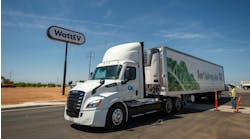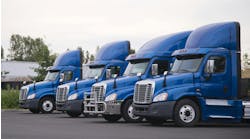The question of who should be held accountable for the tires and wheels in a trucking organization is one that has been debated by fleet managers for decades. A comprehensive tire program involves many departments, the most obvious being purchasing and maintenance, which address price and quality issues, respectively. But input from management, drivers, technicians, and sales and marketing staff can also contribute to controlling the costs and maximizing the performance of what is probably the second-largest expense for most fleets.
Tires and wheels purchased as components on new equipment should be coordinated with replacement purchasing programs, for example. This is especially important when new tire standards are being phased in or when older designs are being phased out. Coordinating replacement tire purchases with vehicle trade cycles can contribute to better prices from used vehicles or trade-ins.
Some fleets have traditionally selected tires based primarily on the fuel-consumption data of a particular brand. But this may be a shortsighted approach. In fact, tread pattern, tire size, retread pull point, retread process, supplier selection and inflation maintenance can have fuel economy benefits that are so dramatic they make brand differences pale in comparison.
Tire size and tread selection influence a wide range of factors, including vehicle traction, handling, noise and ride. For example, some driver complaints of hard steering and slow-speed handling can be easily eliminated by substituting open-shoulder lug tread drive tires for closed-shoulder rib designs on drive axles, especially if vehicles are used in a delivery service that has high frequency and severity of wheel cut. Consequently, local delivery trucks could be fitted with retread drive tires having these qualities, while the more quiet and fuel-efficient closed shoulder original tread drives could be used on over-the-road units.
Spec'ing multiple wheel types, just like axle-specific tread patterns, can optimize driver satisfaction as well as cost-per-mile performance. But it can also restrict interchange flexibility and increase inventory requirements, and thus costs. In some fleets, however, spec'ing different sizes and types of tires is a way to enhance safety or maintenance issues by forcing axle-specific applications. Heavy haulers that require extra load rated tires on certain axle positions are one such example.
The selection of emergency road service providers should balance the interests of cost control, minimized downtime, availability of preferred tire and wheel size/types in sufficient quantities based on anticipated fleet routes and traffic densities. A fleet with a high concentration of just-in-time manufacturing plant deliveries may choose different levels of spare tire inventory, or even different service providers, than a fleet with no penalties for late deliveries.
One common thread that runs through the pursuit of an optimal tire and wheel program in all but the smallest fleet is the need for open communication between departments. To make the best decisions, determine which fleet operations are affected by tire and wheel selections, including service options.
The real challenge is to discover and use this information productively, without creating any internal company dissatisfaction or making decisions that result from minor considerations overriding more major ones. That requires being people smart as well as product smart — both essential qualities of a modern maintenance manager.


